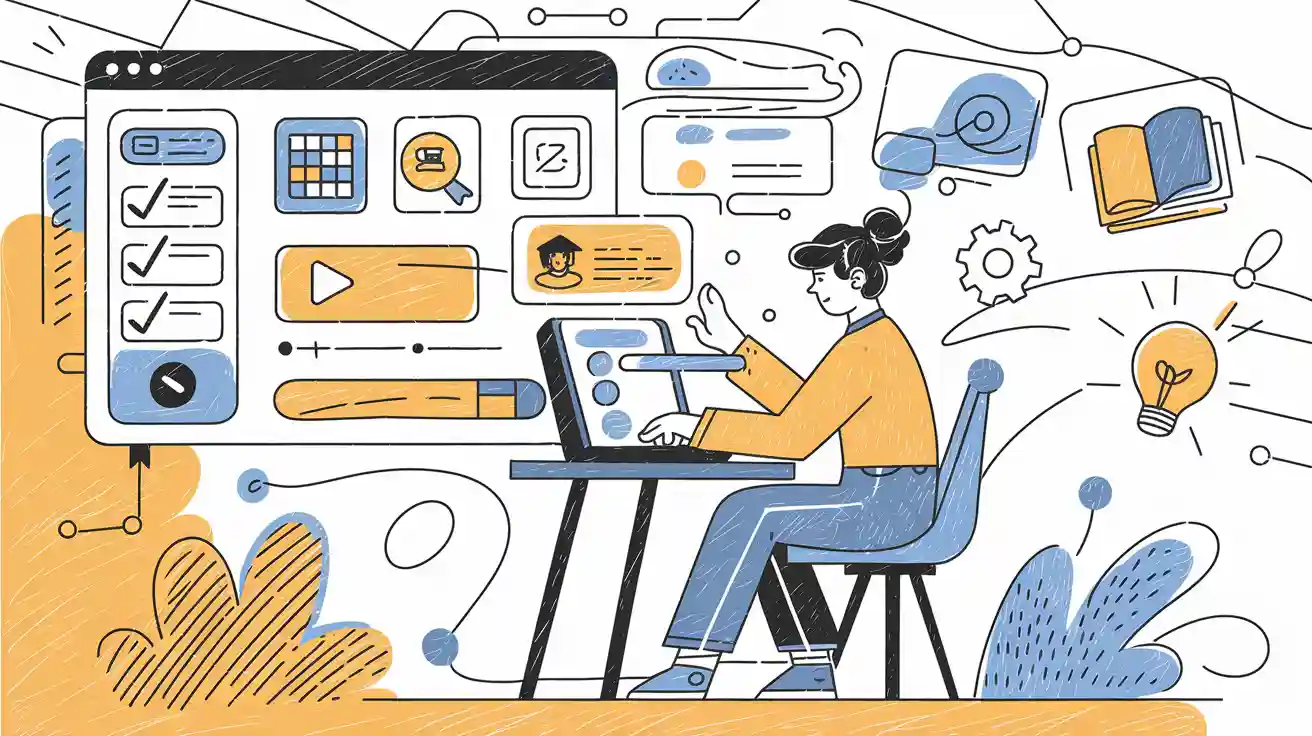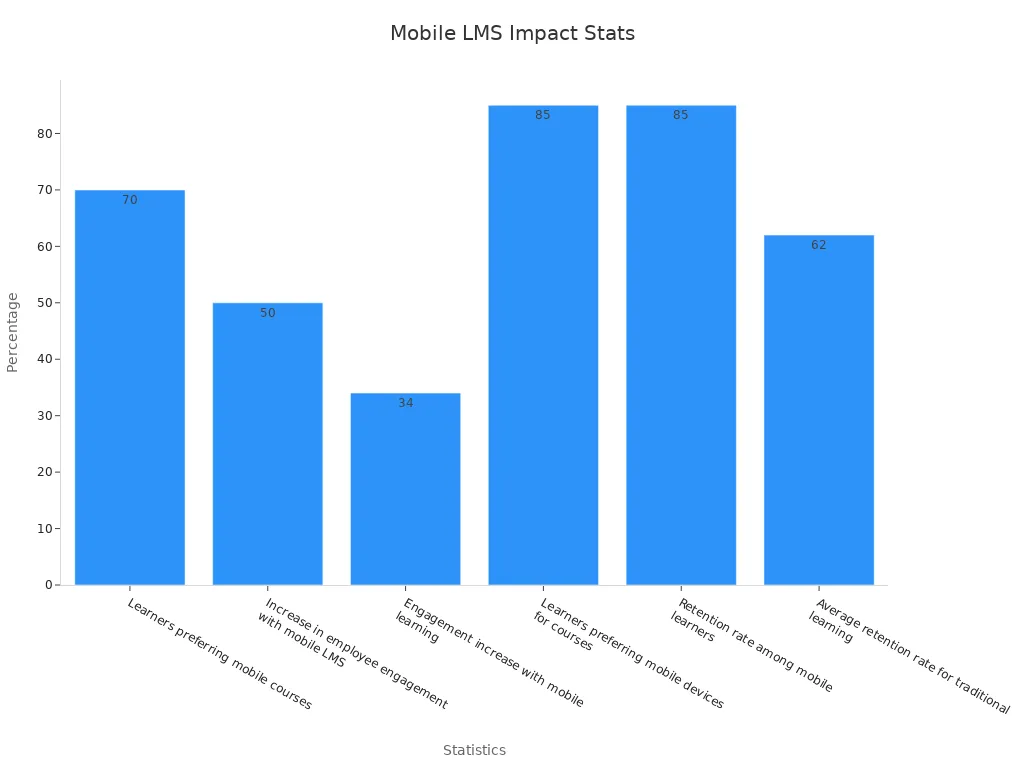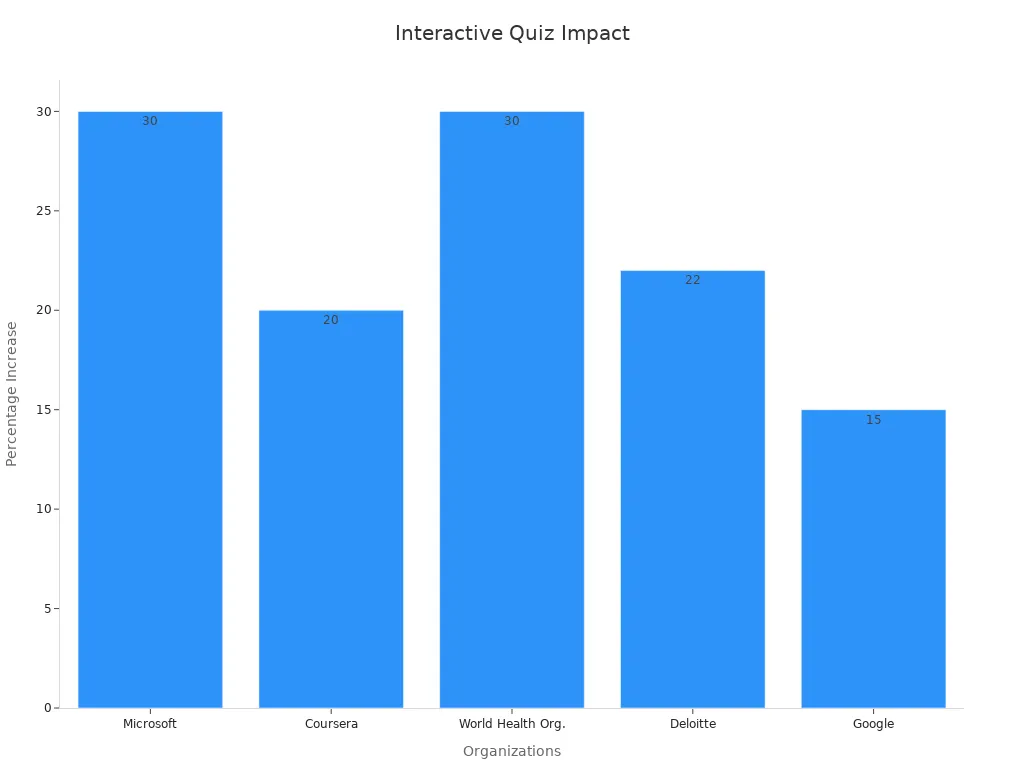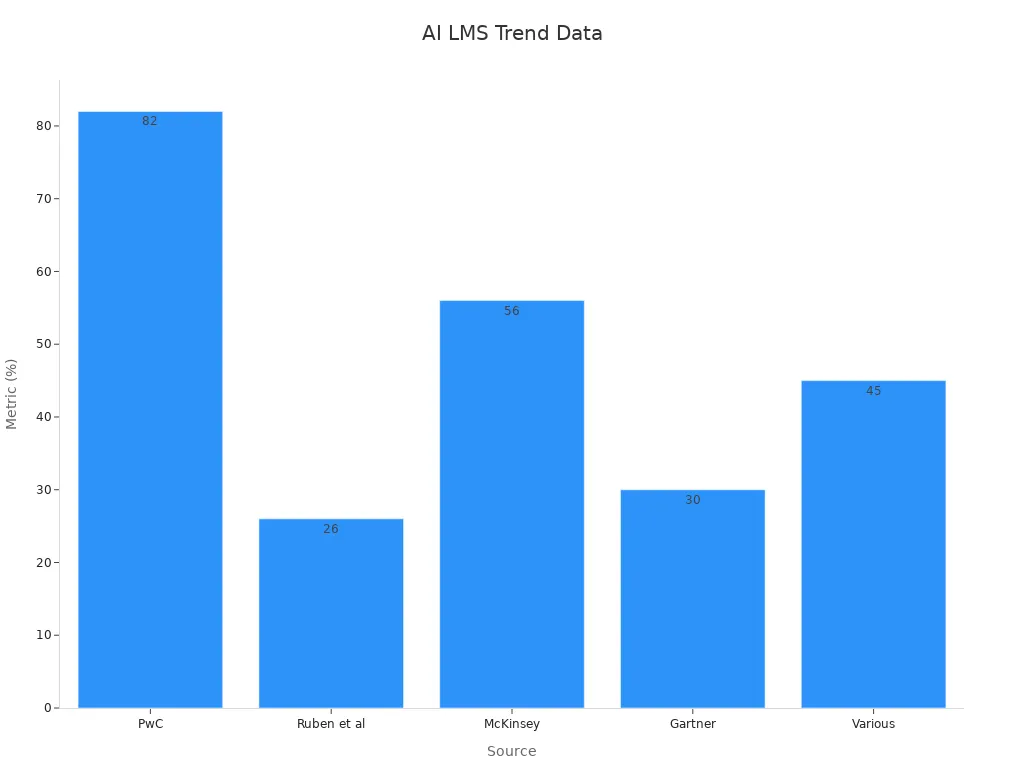7 Key Features of the Best Learning Management Systems (LMS) for 2025

A robust learning management system has become essential for modern education and corporate training. The LMS market is evolving rapidly, driven by the increasing demand for accessible, flexible learning solutions. Consider these key statistics:
The global LMS market is projected to hit $28.1 billion by 2025.
Mobile learning is growing at an annual rate of 36.45%.
North America alone contributes 33% to global LMS growth.
These trends highlight the need for platforms that adapt to diverse user needs and technological advances. As you explore LMS options, understanding their core features will help you make informed decisions.
User-Friendly Interface

A user-friendly interface is the backbone of any effective learning management system. It ensures that learners and instructors can focus on education rather than struggling with the platform itself. Here are three essential aspects of a user-friendly LMS interface:
Intuitive Design
An intuitive design simplifies the learning process by making tools and features easy to find and use. For example:
Students are 70% more likely to participate in online courses when the interface is visually appealing and easy to navigate.
A seamless design encourages active interaction with course materials, improving the overall learning experience.
Case studies also highlight the impact of intuitive design. A virtual lab simulation for science students used AR and 3D visuals, resulting in over 90% of students finding science more enjoyable and retaining complex concepts better. These examples show how intuitive design directly enhances comprehension and engagement.
Navigation Tools
Efficient navigation tools save time and reduce frustration. Features like search bars, breadcrumb trails, and collapsible menus allow users to move through the platform effortlessly. A well-organized navigation system ensures that learners can quickly access their courses, assignments, and progress reports. This ease of use fosters a positive experience, encouraging learners to stay engaged with the platform.
Customizable Themes
Customizable themes allow institutions to tailor the LMS to their unique branding and user preferences. Personalization improves user satisfaction and engagement. For instance:
A community college in Michigan saw a 30% increase in course completion rates after implementing custom features like gamified learning modules.
The British Columbia Institute of Technology experienced a similar 30% boost in student engagement by adopting a customized LMS solution.
These examples demonstrate how customization can transform a standard LMS into a platform that resonates with its users, ultimately driving better outcomes.
Mobile Compatibility
Mobile compatibility is a critical feature for any modern learning management system. With the increasing reliance on mobile devices, ensuring seamless access across various platforms enhances learner engagement and satisfaction. Let’s explore the key aspects of mobile compatibility.
Responsive Design
Responsive design ensures that your LMS adapts to any screen size, providing a consistent experience across devices. This feature eliminates the frustration caused by poor mobile compatibility, which affects 70% of learners. It also broadens your audience reach by making content accessible on smartphones, tablets, and desktops without compromising quality.
For example, responsive design incorporates user-friendly features like swiping and zooming, which improve navigation on smaller screens. This approach not only enhances usability but also ensures that learners can focus on their courses without distractions.
Accessibility Across Devices
Accessibility across devices ensures that all learners, regardless of their physical abilities or preferred devices, can engage effectively with the LMS. Features like screen reader compatibility, keyboard navigation, and sign language support make the platform inclusive for everyone.
A sign language cam feature supports interpreters, improving communication for learners who rely on this mode of interaction.
Screen readers provide audio feedback, enabling visually impaired users to access content.
Keyboard navigation aids users who face challenges with traditional input devices.
These features create an equitable learning environment, ensuring that no learner is left behind.
Mobile-First Learning
Mobile-first learning prioritizes delivering content directly to learners’ devices, allowing them to access training materials anytime, anywhere. This strategy improves flexibility and engagement. For instance:
A PwC study found that employees in mobile-friendly training programs were 70% more proficient in job-related skills.
Starbucks implemented a mobile training program, which increased engagement and retention rates.
Mobile LMS platforms offer interactive features like gamification and instant feedback, making learning more engaging.
By adopting mobile-first learning, you empower learners to take control of their education, leading to better outcomes and higher satisfaction.

Customizable Course Creation
Customizable course creation is a game-changer for educators and organizations. It allows you to design courses that align with specific learning goals, ensuring a tailored experience for every learner.
Flexible Course Builders
A flexible course builder empowers you to create courses that suit your unique teaching style. Drag-and-drop tools, modular layouts, and interactive elements simplify the process. For example, you can quickly add quizzes, videos, or assignments to enhance engagement.
Customizable reporting features also play a vital role. They help you track learner progress, identify areas for improvement, and optimize the learning experience. Here's how these features impact teaching effectiveness:
Feature | Benefit |
|---|---|
Progress Tracking | Helps monitor learner performance in real-time. |
Data-Driven Insights | Enables informed decisions to improve course content. |
Enhanced Engagement | Boosts motivation by tailoring content to learner needs. |
Multimedia Integration
Multimedia integration transforms static lessons into dynamic learning experiences. Adding videos, animations, and audio can make complex topics easier to understand. Studies show that multimedia technologies significantly enhance learning outcomes.
Study | Findings |
|---|---|
Latini et al. (2020) | Highlighted challenges in multimedia comprehension for some learners. |
Naluwooza et al. (2023) | Found that multimedia fosters engagement and personalized learning. |
Ismoilovich & Ravshanbekovich (2023) | Emphasized the importance of ICT in enhancing digital-age education. |
By incorporating multimedia, you can cater to diverse learning styles, ensuring better comprehension and retention.
Templates for Diverse Needs
Templates simplify course creation by offering pre-designed layouts for various educational purposes. Whether you're designing a corporate training module or a school curriculum, templates save time and effort.
Here are some popular LMS templates and their features:
Template Name | Key Features | Customization Options |
|---|---|---|
Eikra Education | Robust LMS, event management | High |
Edubin | Course listings, teacher profiles | Highly customizable |
LMSmart | Quizzes, assignments, certification | User-friendly |
Turitor | Versatile, suitable for various purposes | Extensive customization options |
These templates ensure that your learning management system meets diverse educational needs, making it easier to deliver impactful courses.
Advanced Reporting and Analytics
Advanced reporting and analytics empower you to make informed decisions about your learning management system. By leveraging data, you can optimize learner outcomes and improve the overall effectiveness of your platform.
Performance Tracking
Performance tracking tools allow you to monitor learner progress and identify areas for improvement. Metrics such as login frequency, time spent on activities, and assessment scores provide valuable insights into learner behavior. For example:
Study | Findings |
|---|---|
Siemens et al. (2019) | Strong predictors of student success include login frequency and time spent on activities. |
Nguyen and Walker (2021) | Predictive models based on LMS data achieved 85% accuracy in forecasting grades. |
Zhang et al. (2022) | Refined engagement metrics highlight the multifaceted nature of learner engagement. |
These tools help you understand how learners interact with the platform, enabling you to refine course content and improve educational outcomes.
Engagement Metrics
Engagement metrics reveal how learners interact with your learning management system. They track behaviors such as time spent on modules, participation in discussions, and course completion rates. This data provides a deeper understanding of learner dedication and areas needing support.
Engagement metrics uncover patterns in user interactions, enabling tailored instructional strategies.
Metrics like course completion rates highlight the effectiveness of your courses.
Data analytics help identify at-risk learners, allowing you to implement timely interventions.
For instance, tracking engagement metrics can show which modules learners struggle with, helping you adjust content to better meet their needs.
Data-Driven Insights
Data-driven insights transform raw data into actionable strategies. By analyzing metrics, you can optimize your LMS functionality and improve learner outcomes. Consider these case studies:
Case Study | Description | Outcome |
|---|---|---|
Tech Company | Analyzed employee training outcomes. | Enhanced training sessions. |
Major Retail Company | Tailored training content using analytics. | |
Multinational Tech Firm | Implemented advanced LMS strategies. | 50% boost in overall productivity. |
These examples demonstrate how analytics can refine your approach, ensuring your LMS delivers maximum value to learners and organizations alike.
Gamification Features

Gamification transforms learning into an engaging and rewarding experience. By incorporating game-like elements, you can boost motivation, improve retention, and create a sense of accomplishment for learners. Here are three key gamification features that elevate any LMS.
Badges and Leaderboards
Badges and leaderboards introduce a competitive edge to learning. They recognize achievements and encourage learners to strive for higher performance. For example:
A university implemented a gamified system with badges and leaderboards, resulting in a 50% increase in student engagement and improved course completion rates within one semester.
Research shows that gamified learning can boost engagement by up to 60%, highlighting the motivational impact of competition.
These features not only foster healthy competition but also create a sense of community among learners. When you reward progress with badges or display rankings on leaderboards, learners feel motivated to participate actively and achieve their goals.
Interactive Quizzes
Interactive quizzes make learning more dynamic and enjoyable. They test knowledge while keeping learners engaged. Studies have shown their effectiveness in improving retention and performance:
Organization | Improvement Metric | Percentage Increase |
|---|---|---|
Microsoft | Employee performance metrics | 30% |
Course completion rates | 20% | |
World Health Org. | Knowledge retention | 30% |
Employee engagement scores | 22% | |
Team productivity | 15% |
Interactive quizzes also provide instant feedback, helping learners identify areas for improvement. By incorporating multimedia elements like videos or animations, you can make quizzes even more engaging and effective.

Motivation Through Play
Gamification taps into the natural human desire for play, making learning enjoyable and rewarding. Research shows that students in gamified assessments score 14% higher than those in traditional settings. This demonstrates how play-based strategies enhance knowledge retention and engagement.
Gamification Element | Impact on Learning Outcomes |
|---|---|
Leaderboards | Encourages competition and engagement |
Points | Motivates learners to achieve more |
Badges | Recognizes achievements and boosts morale |
For example, a global marketing firm saw a 45% increase in employee performance metrics after implementing gamified learning. By incorporating elements like points, challenges, and rewards, you can create an LMS that inspires learners to stay committed and achieve their best.
Integration with Third-Party Tools
Modern LMS platforms thrive on their ability to integrate seamlessly with third-party tools. These integrations enhance functionality, streamline workflows, and improve the overall learning experience. Let’s explore three essential integrations that elevate LMS platforms.
Video Conferencing
Video conferencing tools bring a new dimension to virtual learning. They enable real-time interaction between instructors and learners, making online education more engaging. Platforms like Zoom, Microsoft Teams, and Google Meet integrate effortlessly with LMS systems, offering features such as automated attendance tracking and session recordings.
Collaborative learning through video conferencing can boost retention rates by up to 60%.
Engaged learners are 30% more likely to achieve higher grades.
Automated reports for attendance and completion rates simplify performance tracking.
These tools also support Virtual Instructor-Led Training (VILT), which combines the flexibility of online learning with the effectiveness of live instruction. By integrating video conferencing, you can create a dynamic and interactive learning environment.
Payment Gateways
For organizations offering paid courses, integrating payment gateways is essential. These tools simplify the enrollment process by allowing learners to pay directly through the LMS. Popular options like PayPal, Stripe, and Razorpay ensure secure and hassle-free transactions.
Payment gateway integration also supports features like:
Subscription models for recurring payments.
Discount codes to attract more learners.
Automated invoicing for better financial management.
By streamlining payments, you can focus on delivering quality education while providing a seamless experience for your learners.
Communication Apps
Communication apps integrated into LMS platforms foster collaboration and engagement. Tools like Slack, Microsoft Teams, and Discord offer features such as discussion forums, group projects, and idea-sharing spaces. These features encourage participation and build a sense of community among learners.
For example, discussion forums allow students to exchange ideas, while group projects promote teamwork. These tools not only enhance collaboration but also make learning more interactive and enjoyable. A well-connected LMS ensures that learners stay engaged and motivated throughout their educational journey.
Benefits | Examples | |
|---|---|---|
Zapier | Simplifies integration with minimal technical knowledge | Connects LMS with MailChimp |
Middleware Solutions | Automates customer onboarding and streamlines training workflows | HubSpot, Zendesk |
CRM Integration | Enhances customer training and tailors content to needs | Salesforce |
HR System Integration | Streamlines employee training and compliance tracking | Automatic course assignments |
Project Management | Improves tracking of training progress with real-time updates | |
Gamification | Engages learners through interactive elements like leaderboards and rewards | Various gamification tools |
By leveraging these integrations, you can transform your LMS into a comprehensive and efficient learning ecosystem.
AI-Powered Features for Personalized Learning
Artificial intelligence is revolutionizing how you interact with a learning management system. By leveraging AI-powered features, you can create personalized learning experiences that cater to individual needs and preferences. Here are three key ways AI enhances learning.
Content Recommendations
AI analyzes your learning behavior to suggest tailored content that matches your goals. It evaluates data points like skill levels, engagement patterns, and past performance to deliver personalized recommendations. This approach ensures you focus on the most relevant materials, saving time and boosting efficiency.
Feature | Benefit |
|---|---|
Personalized Learning Experiences | Creates individualized training paths based on your preferences. |
Engagement and Retention | Keeps you motivated and reduces dropout rates. |
Efficient Skill Development | Targets your knowledge gaps to accelerate learning. |
Resource Optimization | Directs you to the right materials, reducing unnecessary costs. |
Real-time Performance Monitoring | Adjusts content dynamically based on your progress. |
These recommendations not only enhance your learning experience but also optimize resources for organizations using the platform.
Real-Time Assessments
Real-time assessments powered by AI provide instant feedback, helping you identify strengths and weaknesses immediately. This feature adapts to your performance, offering questions that challenge your abilities while addressing areas for improvement.
AI automates grading, reducing instructor workload.
Adaptive assessments adjust to your learning pace and skill level.
Timely feedback improves your understanding and boosts achievement.
Students using real-time assessments have shown a 22% increase in course performance.
With real-time analytics, educators can monitor your progress and refine their teaching strategies. This dynamic approach ensures you stay on track and achieve your learning objectives.
Predictive Analytics
Predictive analytics uses historical data to anticipate your future learning needs. By analyzing patterns in your behavior, AI can proactively adjust the curriculum to align with your goals.
For example, predictive models forecast which topics you might struggle with, allowing the system to offer additional resources before challenges arise. This feature enhances your learning experience by keeping you ahead of potential obstacles.
Benefit | Description |
|---|---|
Proactive Curriculum Design | Adapts content based on anticipated needs. |
Improved Learning Outcomes | Helps you overcome challenges before they impact your progress. |
Enhanced Engagement | Keeps you motivated with tailored learning paths. |
Predictive analytics ensures your learning journey remains smooth and effective, making the most of your time and effort.
Build Custom AI-Powered LMS in Momen
Building a custom AI-powered LMS has never been easier, thanks to platforms like Momen. This no-code, full-stack solution empowers you to design a learning management system tailored to your specific needs. Whether you’re creating a corporate training hub or an online education portal, Momen provides the tools to bring your vision to life.
Why Choose Momen?
Momen simplifies the LMS creation process by offering intuitive features that save time and resources. Here’s how it stands out:
Customizable Course Structures: Use Momen’s visual builder to design interactive courses and learner journeys. You can manage user roles, add multimedia elements, and create dynamic experiences—all without writing a single line of code.
AI Integration for Personalization: Momen’s AI tools, like its Q&A agent powered by Retrieval-Augmented Generation (RAG), enable personalized learning. These features automate tasks such as content recommendations and real-time feedback, enhancing the learner experience.
Efficient Backend Workflows: Automate essential tasks like progress tracking, user management, and payment processing. Momen’s no-code interface ensures you can focus on delivering quality education rather than managing technical complexities.
New Tutorial Available: Build Your Own Custom AI-Powered LMS
Momen has released a comprehensive tutorial series that guides you through the entire process of creating a custom AI-powered LMS. From frontend design to backend configuration, this playlist covers everything you need to know to build your own LMS, including AI features, user management, and course structures.
Check out the full tutorial here: Momen Custom AI-Powered LMS Tutorial. Start following the steps and create a personalized, feature-rich LMS in no time!
The Growing Demand for AI-Powered LMS Solutions
Organizations increasingly recognize the value of AI in training and education. Recent studies highlight this trend:
Source | Evidence | Key Finding |
|---|---|---|
PwC | 82% of organizations plan to increase investment in AI-driven training | Indicates strong future adoption of AI-powered LMS solutions. |
Ruben et al. | Companies using AI-driven systems have a 26% higher employee retention | Highlights the effectiveness of AI in retaining skilled talent. |
McKinsey | 56% more likely to align training outcomes with organizational goals | Shows the strategic value of AI in employee development. |
Statista | Average savings of $1.3 million annually for organizations using AI | Demonstrates cost-effectiveness of AI-powered LMS platforms. |
Gartner | 30% reduction in time managing training programs with AI LMS | Reflects efficiency gains from automation in training management. |
Various | 45% increase in training program efficiency with AI LMS | Indicates improved productivity and ROI from AI-enhanced training solutions. |

Scale Your LMS with Momen
Momen allows you to deploy your LMS quickly and at scale. Whether you’re a solo creator or a large organization, Momen’s flexibility ensures your platform grows with your needs. By choosing Momen, you can focus on delivering impactful learning experiences while leaving the technical challenges behind.
The seven key features of LMS platforms—user-friendly interfaces, mobile compatibility, customizable course creation, advanced analytics, gamification, third-party integrations, and AI-powered personalization—are essential for meeting the demands of 2025. These features ensure that learning systems remain adaptable, engaging, and effective.
The educational landscape is rapidly evolving. LMS platforms must embrace innovation to deliver personalized and immersive experiences. Trends like predictive analytics and mobile-first learning highlight the importance of staying ahead in a competitive market.
Evaluate LMS options carefully. Choose a platform that aligns with your goals and leverages these features to enhance learning outcomes and engagement.
FAQ
What is an LMS, and why is it important?
A Learning Management System (LMS) is software that helps you manage, deliver, and track educational content. It simplifies learning processes, improves accessibility, and enhances engagement for learners and instructors.
Can I use an LMS for corporate training?
Yes, LMS platforms are ideal for corporate training. They help you create tailored courses, track employee progress, and ensure compliance with industry standards. Many organizations use LMS to boost productivity and skill development.
How does AI improve LMS functionality?
AI enhances LMS by personalizing learning experiences. It recommends content, provides real-time feedback, and predicts learning needs. These features help you save time, improve engagement, and achieve better outcomes.
Are LMS platforms mobile-friendly?
Most modern LMS platforms support mobile compatibility. You can access courses, complete assignments, and track progress on smartphones or tablets. Mobile-first learning ensures flexibility and convenience for learners.
What integrations should I look for in an LMS?
Look for integrations like video conferencing tools, payment gateways, and communication apps. These features streamline workflows, improve collaboration, and enhance the overall learning experience.
See Also
Discover 8 Essential B2B SaaS Concepts for 2025
Explore 10 Innovative SaaS Startup Concepts for 2025
Top No-Code Tools for Freelancers in 2025

